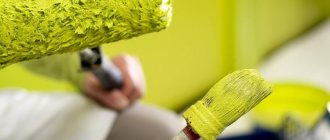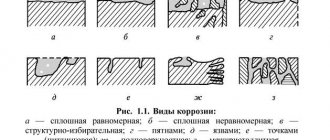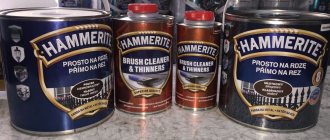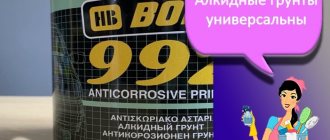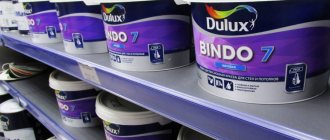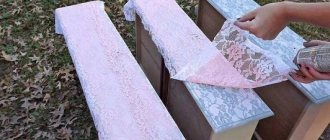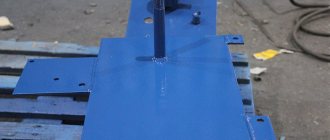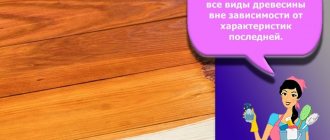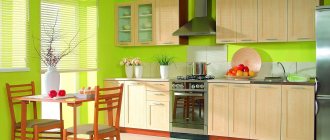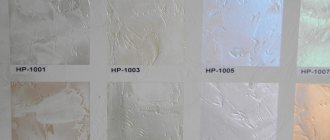Compositions for painting metal must exactly correspond to the characteristics indicated on the marking. The main feature of metal paints is to prevent corrosion and increase service life.
What types of paints are there, how to determine the quality of metal and how to paint metal surfaces correctly?
We will learn about this in our article.
Why do you need to paint metal?
Gates, canopies, garage boxes or any other metal structures begin to deteriorate over time and require updating. This is especially true for structures that are located in the fresh air.
The main enemy of all metals is water (especially salty) and oxygen. The reaction of oxygen and water starts oxidation processes that are not so easy to stop.
There are types of metals that are resistant to corrosion, for example, aluminum, which is coated with a special protective layer - aluminum oxide.
But if the surfaces are not treated with protective compounds, the parts will quickly rust, and the structure itself will become fragile and may leak in some places.
Metal parts have a smooth surface: for this reason they have poor adhesiveness (adhesion to the surfaces of solid or liquid bodies). This means that not all paint and varnish compositions may be suitable.
High-quality anti-corrosion paint for metal should not only adhere well, but also protect the metal from moisture. If you choose a bad material, then within a year the gate will be covered with rust and begin to creak.
Hammer
This paint contains polymer resins that have excellent adhesion to metal and form a very strong and durable coating that reliably protects it from corrosion. As can be judged from numerous photographs, it is somewhat reminiscent of the imprints of a large hammer in its texture, which explains the very unusual name.
This product is sold as a ready-made mixture, mainly in cans. It can be used without prior priming, since it itself is to some extent endowed with the qualities of a primer, filling all the small cracks and irregularities on the metal surface.
The product is absolutely insensitive to the effects of humidity, temperature changes and ultraviolet radiation, resistant to mechanical damage, and has increased heat resistance. But there are also disadvantages, which include high cost, high consumption of material, and difficulty in removing the old coating.
Pre-primer: types of mixture, which one to choose?
Before painting, it is recommended to apply a layer of primer to the metal - the solution not only reduces the consumption of paints and varnishes, but improves adhesion to surfaces, slows down oxidation processes and enhances the protective function of the structure.
The primer differs in composition; the choice of solution depends on the degree of damage.
Types of soil:
- Passivating - thanks to chromic acid salts (chromates), the metal becomes less susceptible to moisture. The more chromates in the composition, the slower rust forms.
- Insulating – primer with the addition of epoxy or alkyd compounds. Economy option, suitable for black metals, parts are covered with a protective, water-repellent film.
- Phosphating – galvanized iron is most often processed; primer is more of a passivating composition (suitable for restoration of non-ferrous metals).
- Protective - contains phosphoric acid, which forms a water-repellent foam on metal, suitable for treating old, rusty structures.
- Inhibiting is a relatively new water-based composition that stops the formation of rust and increases shelf life.
Regardless of the composition and its purpose, the primer mixture is available in different colors and is never transparent - this makes it easier to notice missed areas when painting and paint over them.
By what criteria to choose paint: types and characteristics
Enamel helps protect metal surfaces from the negative effects of ultraviolet radiation and moisture. The main thing is to choose the right paint material.
What should you know?
Paint for metal surfaces differs in application temperature.
To ensure that the layer lays evenly, follow the instructions on the can - if the temperature is +2° or +11°, then you need to paint the fence only at this temperature.
Also, do not forget about the maximum indicators after the paint has dried: if the specified temperature is exceeded, the surface will begin to deteriorate.
It is important to know what solvents can be used to dilute materials. Water-based paints do not have a strong odor, and with the addition of a solvent, not only the toxicity increases, but also the cost of the composition.
There are enamels that can only be applied to a clean, grease-free metal surface, and there are paints for painting metal surfaces against rust - for heavily damaged parts (the composition contains solutions that remove old corrosion).
Rust paint is applied directly to the untreated surface.
Some compositions dry in 4-5 hours, while others dry in 11-12 hours.
There are also differences in the method of application - for painting large areas it is recommended to use a roller (then the paint must be selected according to thickness), and for small structures (for example, a gate) it is more economical to use a brush.
An important factor is the ability of the paint and varnish material to cover the color of the surface (hiding power).
1 liter of paint can take from 7-8 to 12-13 m2. The amount of paint consumed depends on the saturation of the previous layer.
The final result is influenced by the chosen color: matte, semi-matte or a shade with added gloss.
Some paints are intended for painting metal parts indoors, while others are suitable only for exterior facade work. It is better to choose 3 in 1 paints for metal - they are multifunctional.
When painting a heating system or chimney, it is important to take into account the ability of the materials to withstand stress caused by high temperatures - the higher the heat resistance, the higher the quality of the paint and the longer it will last.
How to choose metal paint and what to pay attention to?
If you plan to paint metal products, you should choose paints that are designed specifically for such surfaces.
When choosing, pay attention to the following parameters:
- Purpose . You should consider where the surfaces to be treated are located, since there are separate products for external and internal work.
- The need for priming . Some formulations already contain a primer, so the surface does not need to be pre-treated. As a rule, such products are more expensive than conventional enamels without a primer.
- Method of application . It depends on the viscosity indicators. Paints with high viscosity are applied with a brush, with medium viscosity - with a roller, and liquid emulsions are sprayed.
- Drying time . This indicator is also usually indicated in the instructions. Quick-drying paints are more often used for outdoor work, when it is necessary for the paint layer to dry quickly and not cause dust to appear on it.
In addition, it is advisable to familiarize yourself with the expected frequency of coverage renewal. It is desirable that the paint service life be 8-10 years without cracks or other damage.
What colors are there and how are they different?
Oil paint
Thanks to the drying oil in the composition, a water-repellent film is formed on the surface of the parts. Drying oil is an oily liquid obtained from vegetable oils.
After application, it thickens and dries very quickly. Drying oil can be linseed, hemp, sunflower (hardens the longest).
It is not recommended to use oil paint on zinc or aluminum; it simply won’t stick. Drying oil-based paint is good for pre-priming.
The advantages are a beautiful coating, no pungent odor, and low cost.
Minuses:
- After only 3 years, the surface needs to be repainted.
- Fades quickly when exposed to the sun.
- Low corrosion protection, metal surface may rust under a layer of paint.
- Suitable for temporary use only.
Nitro paint (nitra)
Nitrocellulose enamel for metal is characterized by fast drying, but a very pungent odor. After just half an hour, the painted parts are ready for use. Quick drying largely depends on the application method. Most often, a spray gun is used for painting.
The smell of enamel is so strong that hospitals, sanatoriums, schools and kindergartens do not buy paint. Due to toxicity and increased flammability, restrictions on painting are noted in Russian laws.
You can work with enamel indoors only with good ventilation.
Pros:
- Quick-drying paint for metal.
- Does not require dilution with solvents.
- Economical consumption (1 m 2 up to 120 g, if several layers are applied, and about 30 g if one layer is applied).
- Affordable price.
It is better to buy enamel in special cylinders. Nitroenamel can be used to paint not only metal, but also wood and concrete. Sometimes the paint is diluted with acetone.
Alkyd enamel
Universal, environmentally friendly, durable (the metal retains its original appearance for at least 10-20 years), comes in different colors, as well as glossy and matte.
The main component of the paint is alkyd pentaphthalic and glypthal varnish, which enhances gloss.
The enamel base is pentaphthalic resin, vegetable or tall oil. It is recommended to paint in several layers using a spray gun or brush.
Alkyd paint for metal repels water and protects metal from rust, but you need to look at the markings: digital indicators indicate which surfaces can be painted (PF-133 is suitable specifically for metal). PF is short for pentaphthal.
Pros:
- Resistance to ultraviolet radiation and temperature changes.
- High-quality protection against corrosion (a layer is formed).
- Good price.
- Protection against fungus and mold.
- Preservation of rich color for a long period.
- Durability.
The protective film can withstand cleaning with bleach or bleach.
Buy paint for metal surfaces in accordance with GOST; the mark “TU” means that the manufacturer has diluted the paint with additional solutions, which may have a negative effect on the quality.
The disadvantages include a strong odor (the first sign of toxicity and flammability), drying time, cost and difficulty in selecting the right composition.
Previously, only iron structures were painted with alkyd paint; now enamel is widely used in painting concrete walls.
Before application, you must first clean and degrease the surfaces. If stored for a long time, it becomes thick (then the paint is diluted with white spirit).
Acrylic paint
Water-based compositions are considered the best material for painting metal.
Acrylic paint for metal has good adhesive ability (high level of adhesion to the surface) and a long service life.
After drying, an elastic protective film is formed on the metal surface, which prevents the paint from cracking under the influence of the environment. The substances in the composition prevent the decorative layer from peeling off and neutralize the effect of oxidative processes.
The paint is easily washed off from tools (which means you can use a spray gun without fear), does not fade under the influence of ultraviolet radiation, is not fire hazardous and non-toxic. You can dilute it with plain water.
Epoxy paint
The material contains epoxy resin; sometimes a coloring pigment or resin hardener is added. There are several types of paint materials: two-component enamel (used in everyday life) in the form of powder and aerosol.
Most often, paint is used to update decorative metal parts inside the house, rather than outside.
The peculiarity of the composition is to give gloss to the metal.
Pros:
- Water repellent.
- Non-flammable.
- Elastic.
- Has high adhesiveness.
- Can be applied in one layer.
- Large selection of colors.
- Resistance to aggressive environments (alkalies, acids, salts) and damage.
Epoxy paint is used to paint cars, batteries, oil or gasoline barrels, and tanks.
Hammer (forge) paint
It is worth noting that the price of the material is not low, but the quality is also high. After treatment, even the most rusty parts will appear new.
Composition: synthetic resin, aluminum powder, crushed glass, silicone and additives that increase resistance to adverse weather conditions.
Metal and rust paint masks roughness and minor defects on metal parts, silicone and aluminum powder give surfaces a noble appearance.
Paint can be compared to a polymer coating, a more expensive material (many manufacturers pass off hammer paint as polymer).
Beware of fakes in the markets - the lower the price of paint and varnish material, the higher the likelihood of fraud.
Pros of paint:
- It takes no more than 2 hours to dry.
- Non-toxic, no pungent odor.
- Large selection of colors, does not fade, retains its original appearance for a long time.
- Dust does not stick to the structures.
- No pre-cleaning is required before application.
- After treatment, the composition suppresses the formation of corrosion.
- The maximum service life is up to 10 years.
- After severe damage or impact, the part may bend, but the coating will not break off.
- Safes can be painted.
Minuses:
- High price (from 1000 rubles per 1 kg).
- Removing paint is very difficult; not all solvents help.
Anti-corrosion compounds: types
Paint for painting metal surfaces against rust prevents metal structures from deteriorating and increases their service life.
Types of protective solutions:
- Liquid product (enamel, paint) – applied to a previously primed surface, forms a protective film.
- Primer with zinc admixture (serves as the main protective coating).
- Metal galvination - applying a solution with an electrolyte to a part. A substance that conducts electric current penetrates the first layer on the surface, enhances adhesiveness, and prevents rust from forming.
- Ceramic coating requires high heat. There are different application methods: flame, plasma, paraphase and enameling. The most common method is enameling.
Most often, multifunctional enamels are chosen for coating (rust paint 3 in 1). It is enough to remove the first layer of rust and start painting.
As for the primer, there are two types - for parts with good roughness and adhesive ability, and for aluminum, anti-corrosion, copper and duralumin surfaces.
Anti-corrosion compounds are suitable for painting heating systems (at -20°C, +80°C), and can be applied to surfaces without removing rust.
The downside is the high price.
Rubber paint
Unlike other compounds, which after drying cover the surface with a hard film, rubber paint has a slightly soft protective film.
The basis of the material is water-acrylic. When you open the can, it seems like there is liquid rubber inside.
Contains:
- Finnish latex (gives strength).
- Antifreeze (increases resistance to cold temperatures).
- Coalescent (additive that promotes film formation).
- High-quality pigments, fungicides.
The paint for painting metal surfaces is odorless, there is no solvent in it, which means the solution is non-toxic (you don’t have to ventilate the room when applying).
Suitable for rooms with high humidity and for updating metal roofs.
The paint for painting metal surfaces is elastic, has good adhesion to the surface, and is breathable.
Painted structures can be washed with water; the metal can withstand not only sub-zero temperatures (withstands up to -50-60°C), but also positive temperatures.
Consumption is minimal: 1 kg of paint can be painted up to 7 m2. More paint will be needed for a corrugated surface (approximately 200 g per 1 m2). For smooth, about 150 g.
The paint and varnish material is inexpensive; you can paint not only metal structures, but also concrete, natural stone, brickwork, and boards.
The finish is matte and you can apply varnish on top. You need to start work at a temperature of 3-4°C.
TOP 3 best metal paints for interior work
To paint metal surfaces indoors, special paints are used that dry quickly and have a minimally unpleasant odor.
Hammerite
Inexpensive alkyd paint was specially created for interior painting work.
At the same time, it can also be used for outdoor work, because the emulsion contains a special component that protects treated surfaces from rust.
The product also includes a primer, so the surface does not have to be pre-treated or cleaned..
If there is a need to paint a surface made of plastic or non-ferrous metals, this paint can also be used, but in this case you will have to first apply a layer of primer.
Another feature of the emulsion is that it creates a coating that is resistant to rust and moisture..
Drying time is only 4 hours, so the product is suitable even for painting work, which involves applying several layers of paint for the highest quality finish.
Specifications:
- texture - matte;
- maximum flow rate 10 l/sq.m;
- drying time 4 hours.
pros
- the product contains a primer;
- short drying time;
- masks defects and surface irregularities;
- suitable for indoor and outdoor use;
- wide choice of colors.
Minuses
- difficult to apply with a roller;
- Not all colors can be found on sale.
Cossack MA-15
High-quality domestically produced oil paint is intended for application not only to metal, but also to wooden surfaces.
High-quality drying oils made from vegetable oils are used as a basis for production.
In order for the paint layer to effectively resist moisture and atmospheric conditions, and not crack over time, the surface to be treated should be properly prepared.
To do this, the surfaces are cleaned of the old paint layer, wiped of dust and degreased..
The paint has a moderately thick consistency and can be applied with a regular brush or roller.
Since the paint is oil-based, it has a characteristic unpleasant odor. When carrying out external work this does not play a special role, but when carrying out internal painting work it is necessary to ensure high-quality ventilation of the room.
Specifications:
- texture - glossy;
- type of diluent - solvent;
- Drying time 24 hours.
pros
- affordable cost;
- suitable for painting wood and metal (except floors);
- applied evenly;
- is resistant to moisture;
- does not crack for 8-10 years.
Minuses
- very pungent unpleasant odor;
- cannot be applied by spray.
PANZER
This paint for metal surfaces is absolutely deservedly called one of the best on the market..
This high-tech product provides reliable protection of metal surfaces from rust and aggressive weather conditions.
The paint contains special components that smooth out surface unevenness, so there is no need to grind and level the metal before painting..
At the same time, for high-quality painting and long-term preservation of performance characteristics, the manufacturer recommends first cleaning the surface from dust and dirt, as well as degreasing it in any convenient way.
The consistency of the emulsion is quite thick, so it is better to apply it with a brush or roller.
To speed up the work, it is possible to use a sprayer, but in this case you need to dilute the emulsion to a liquid state with a regular solvent.
Specifications:
- texture - glossy;
- type of diluent - solvent;
- Drying time 6 hours.
pros
- affordable cost with high performance characteristics;
- can be applied by roller, brush or spray;
- forms a perfectly smooth glossy surface;
- increased resistance to moisture;
- protects surfaces from corrosion.
Minuses
- mixes poorly;
- can only be diluted with a special solvent.
Technology: how to properly paint metal surfaces outdoors
It would seem that there is nothing complicated - take a brush and apply a layer. But a lot depends on the preparation of surfaces and the correct choice of paints and varnishes. If you choose a paint that is not suitable for a certain type of metal, it will quickly crack.
Paint for painting metal surfaces outdoors must contain anti-corrosion substances, preferably with rust converters.
How to determine the quality of metal
Most often, fences and other structures are made of black iron, which quickly rusts. To slow down the oxidation process, coat the parts with alkyd primer.
Galvanized metal parts, especially roofs, are painted with alkyd paint.
As for non-ferrous metals (for example, copper is a red metal), they are almost not painted; in extreme cases, they are coated with varnish (epoxy or polyurethane).
Sequence of work execution
If the damage is minor, before starting work, treat the metal surface with a degreasing solution, then the paint will “adhere” well and adhere to the base material.
If the metal is covered with a thick layer of rusty deposits, remove it with a special metalworking tool (scraper). Using a pointed tip, you can remove a layer up to 0.01 mm thick.
There is no need to strip everything down to the base; a thin, uniform layer of rust is acceptable.
If you don’t have a scraper, you can use sandpaper or a brush with metal teeth. A simple metal sponge is suitable for cleaning lightly damaged parts.
You can not remove the rust, but treat it with orthophosphoric acid (included in some solutions) and apply a layer of paint on top. Phosphoric acid is best used in advanced cases.
Important! Before treating metal with any chemicals, wear gloves and a respiratory mask.
After removing rust and treating parts with solvents and degreaser, wait until the structure dries. You cannot apply paint to a wet structure.
It is recommended to wash the structures with plain water and soap.
Which paint is suitable for untreated surfaces:
- The composition contains corrosion inhibitors, substances that slow down the formation of rust.
- The thickness of the protective film is at least 150 microns.
The next step after drying is priming the surface. The primer provides additional protection and enhances adhesion to the material (it is recommended to apply 2 layers).
For ferrous metal, take an anti-corrosion primer, for non-ferrous metal, a mixture with good adhesive ability or varnish.
After the primer has dried, you can begin applying paint.
The nuances of coloring
It is more convenient to paint twisted fences, fences or decorative figures made of iron with a brush - it will get into all hard-to-reach places and paint over small details.
Apply several layers (wait for the first to dry before applying the second).
The number of layers depends on how well the surface was treated and what compounds were used. If there was no pre-treatment or cleaning, then more paint will be needed.
It is easier to paint small areas with an aerosol can, the main thing is not to interrupt during application - the stream should be continuous, and the distance of the spray from the surface should not be more than 20 cm. At least 3-4 layers will be needed.
Before spraying again, you need to wait for the previous layer to dry (about 15 minutes).
It is better to paint metal surfaces over large areas (for example, roofs) with a wide, but not very hard roller. If you paint hard, you will have to go back and paint over the missed areas.
You need to add a solvent to the enamel for exterior use (10% of the volume of the jar).
The maximum number of layers is 3.
Use a roller to paint only a flat surface; corners and joints are painted separately with a brush. Dip the roller into the paint tray, press lightly against the mesh (to avoid splashing) and bring it to the wall or metal surface. The movements need to be made up and down, and the strips themselves should be placed on top of each other with a slight overlap.
Acrylic
Previously, such paints were not used for painting metal; they were used mainly to paint surfaces made of wood, concrete, plasterboard, brick and others. But later it turned out that they are ideal for metal. Such mixtures are made on the basis of a water emulsion with the addition of polyacrylate, dyes and a special anti-corrosion additive.
Acrylic paints are absolutely non-toxic, completely odorless, and when applied form a strong and durable coating. They are well suited for painting heating appliances due to their insensitivity to high temperatures and have a large catalog of colors and shades.
General Painting Tips
It is not always necessary to remove rust. If the corrosion layer is smooth and thin (resembles pollen), then the paint and varnish material will easily adhere to the surface without cleaning.
You cannot apply a coat of paint if the rust has begun to “move away” from the parts or has become swollen. No composition will stick to such a surface. The same goes for non-fat areas.
Metal paint for exterior use must be weather resistant. Choose weather-resistant paint materials.
The matte color masks minor defects well, but if you decide to give the surface a glossy look, then each part must be carefully processed and cleaned before application - gloss does not hide imperfections, but, on the contrary, draws them out.
To save money when painting with a roller, periodically wring it out - the roller absorbs a lot of paint.
Iron does not absorb paint and varnish material, so you only need to apply varnish or enamel in a thin layer (a spray gun is best).
Do not use a sprayer if the paint is fast drying.
Never paint radiators or heating systems while they are on. For pipes it is recommended to use heat-resistant enamel.
You should not buy cheap paints and varnishes. It’s better to buy more expensive metal paint, but then you won’t have to waste time and effort on redoing it. By covering the metal with high-quality enamel, you will increase the service life of the products.
How to apply paint?
Determining what kind of paint is needed for the metal is only the first step. In order for the composition to perform its functions well, it is important to apply it correctly. Typically processing consists of several stages:
- Remains of the old coating are removed from the surface (using a chemical remover or mechanically).
- The metal is sanded.
- The surface is coated with a primer and kept for a certain time according to the instructions.
- Apply the base coat. Depending on the type of composition and features of the structure to be painted, sprayers, rollers, and brushes of different types are used.
- Wait for the first layer to dry, apply a second if necessary.
- Dry the coating completely - at this time it is important to prevent mechanical damage to the wet paint. If toxic substances are released during the drying process, you must follow safety requirements (for example, wear a respirator near the painted surface) until it dries completely. Depending on the type of composition used, the coating may take several hours or days to dry.
Recommendations for selection
When choosing a coloring composition, you must follow the recommendations of experts. Exterior paint is not always suitable for interior use. At the same time, the features of applying the mixture to the surface also differ.
It is important to consider the following:
- If you need to paint heating pipes and radiators, choose a heat-resistant composition that can be used at temperatures of about 150 degrees.
- Black and gray paint work well in domestic spaces, but living spaces require brighter solutions.
- The surface of heating elements is painted before the heating season, when they are cold.
- Furnace elements are painted with compounds that can withstand temperatures up to 500 degrees.
- Non-ferrous metals are coated with special primers, because ordinary ones are not suitable for this.
- If you plan to work outdoors, use organic solvents.
Thus, when choosing a paint for metal finishing, it is important to consider many factors, including temperature, use, corrosion and rust protection, and color after treatment. Only in this case will you be completely satisfied with the result of the work.
